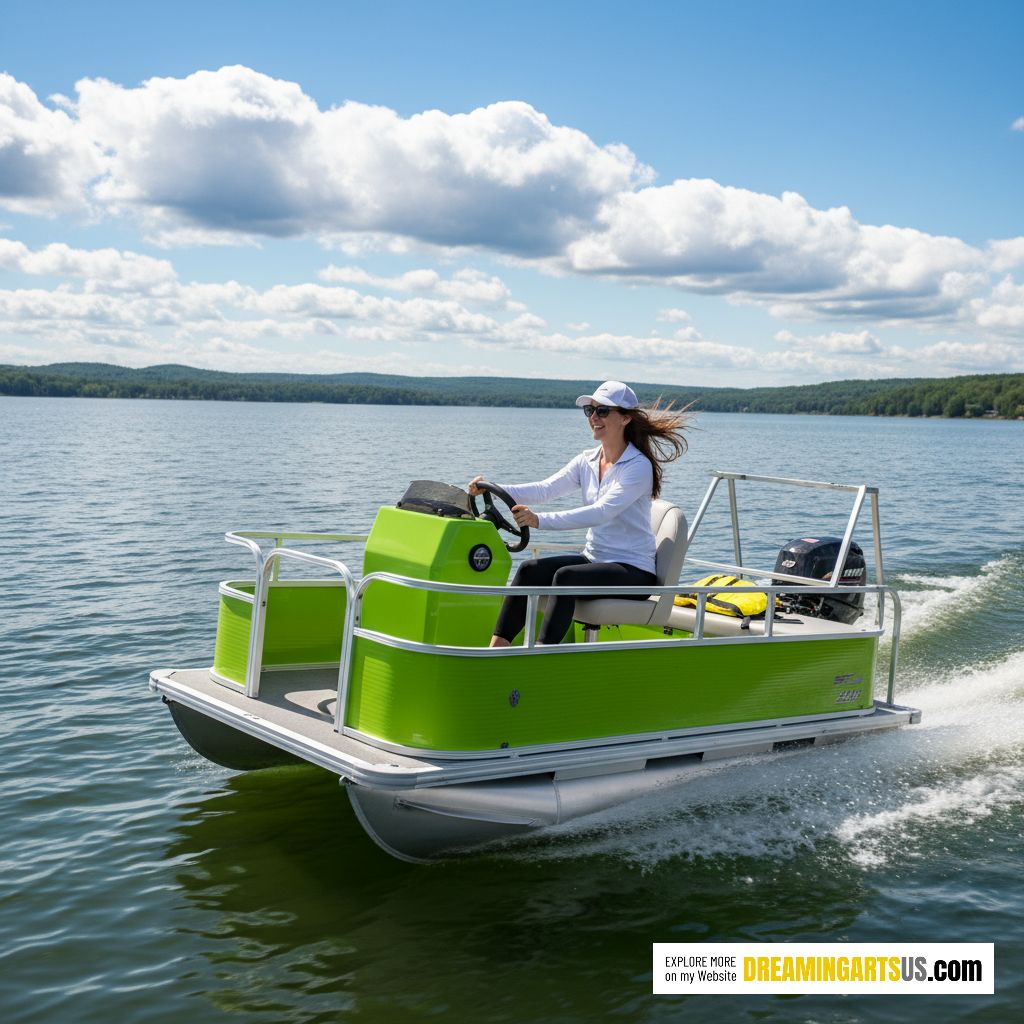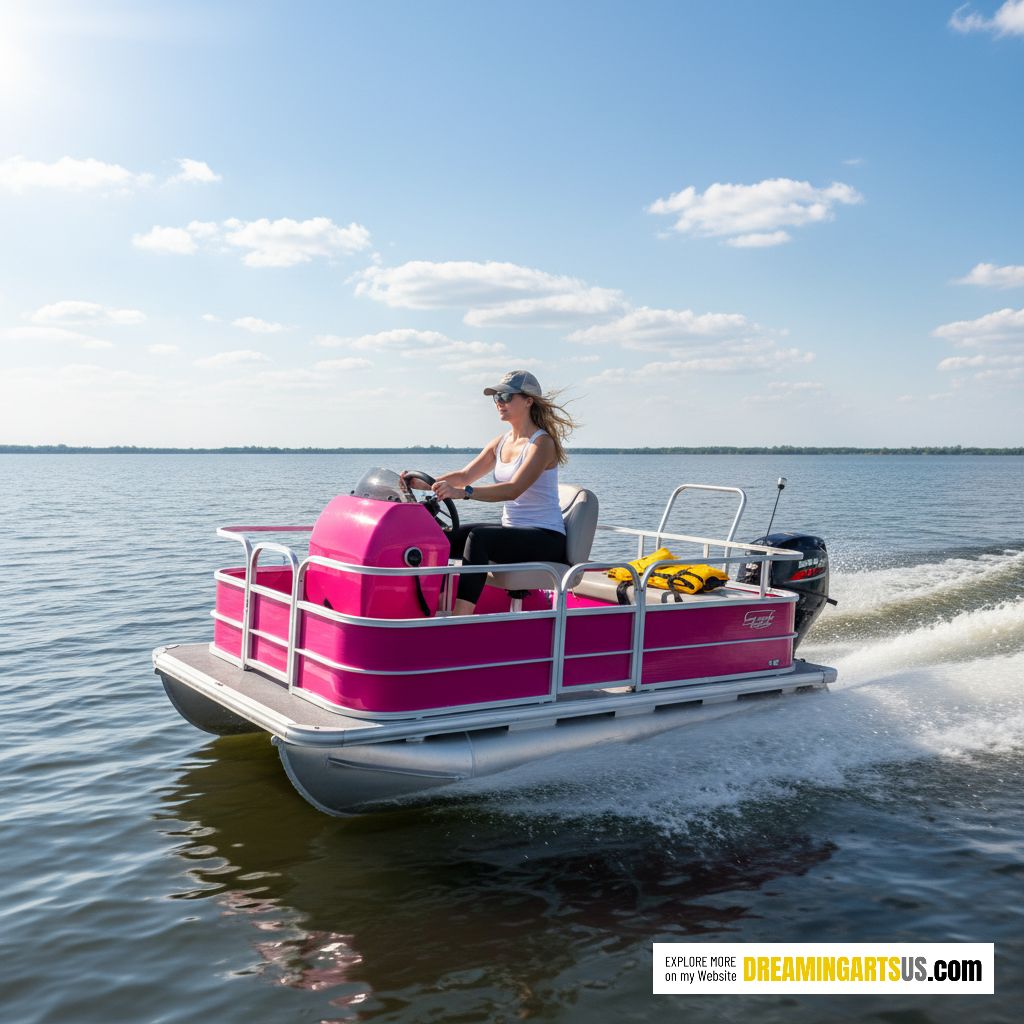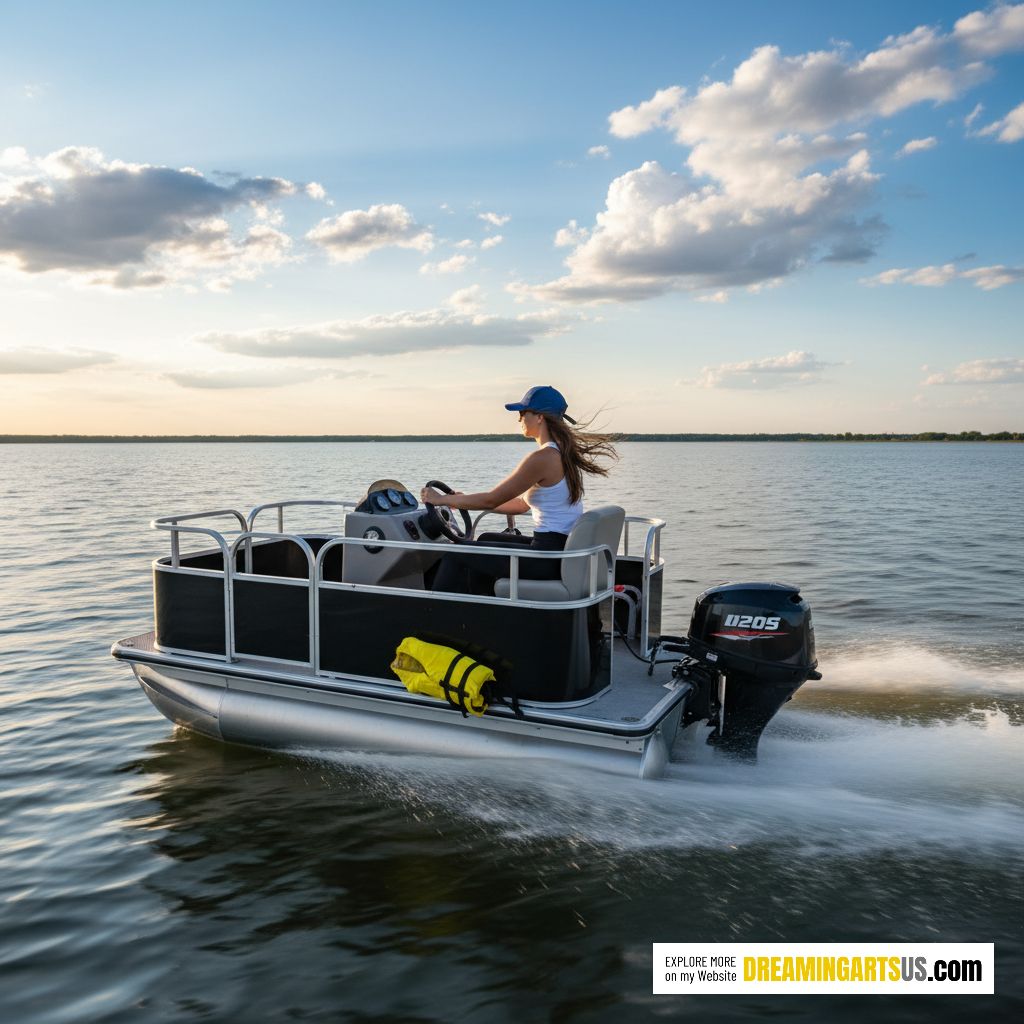There’s a special kind of grin you only see on the water—the one that shows up the second you nudge the throttle, the hull skims flat, and the entire lake opens up in front of you. That grin is the calling card of Personal Pontoon Boats. They’re compact, quick to launch, easy to own, and ridiculously fun to drive. Think of them as the “joy machines” of inland waters: simple to operate like a golf cart, stable like a dock, and versatile enough to switch from solo sunrise cruises to an afternoon of fishing or a sunset snack run with a friend.
If full-size pontoons are the floating living rooms of the lake, Personal Pontoon Boats are the spirited studio apartments—lean, efficient, and optimized for good times. They bring the comfort and stability pontoon fans love, minus the hassle, moorage footprint, and budget of a bigger rig. Whether you’re hopping between coves, teaching a beginner to handle a helm, or carving quiet turns at golden hour, these mini pontoons deliver more smiles per mile than almost anything else on the water.

Why Personal Pontoon Boats Are Having a Moment?
1) Effortless freedom. Tow it with a modest vehicle, launch solo, and be underway in minutes. You don’t need a crew, and you definitely don’t need a marina valet. The whole experience is about independence: your schedule, your route, your pace.
2) Stable by design. Twin or tri-tube flotation spreads your weight and resists rocking. New boaters appreciate that “flat and planted” feel. Anglers love the steady platform when landing fish. Families value the confidence that comes with solid railings and predictable handling.
3) Comfortable all day. A small footprint doesn’t mean cramped. Many models pack a swivel captain’s chair, side benches, drink holders, dry storage, a shade option, and a smooth helm. It feels like a tiny terrace gliding across the water.
4) Surprisingly capable. Pair a lightweight hull with a modern outboard or electric motor and you get punchy acceleration, solid cruising speed, and excellent fuel efficiency. With minimal draft, you can nose into skinny water and tuck into corners bigger boats can’t reach.
5) Truly affordable boating. Price, fuel, maintenance, and storage all land on the manageable side. If you’ve ever looked at the total cost of a large pontoon and sighed, Personal Pontoon Boats are your “yes, finally” moment.
What Sets a Personal Pontoon Apart?
Compact hulls, big utility
Lengths typically run 10–14 feet, with smart layouts that focus on the essentials: helm, a captain’s chair, a buddy seat or bench, and open deck space. Those aluminum tubes are the heart of the platform—light, durable, and happy in shallow water.
Sensible power
You’ll see small gas outboards (often 9.9–30HP) or whisper-quiet electric pods. Gas wins for range and snap. Electric is game-changing for silent cruising, low maintenance, and lakes with motor restrictions. Either way, the boat’s light weight turns modest horsepower into real fun.
Effortless trailering and storage
A single-axle trailer is all you need, and many owners keep their boat at home. No seasonal storage bill. No logistic gymnastics. Hook up, go play, park it.
Creature comforts that matter
Lean-back helm seats, cup holders, bimini tops, easy-clean vinyl decking, integrated swim ladders—many little details add up to a “stay out longer” experience. And yes, there’s room for a cooler.

On-Water Personality: How They Drive and Feel
Drive one and you’ll get it. Personal Pontoon Boats jump on plane quickly (for their category), carve smooth arcs, and stay composed in a light chop. They aren’t built for roaring across whitecaps, but on lakes and gentle rivers they’re a delight. That wide stance keeps everything balanced when you stand to cast or move around. You’ll notice how calm the deck stays when someone shifts weight—there’s far less “tippy” drama than small V-hulls.
Noise is pleasantly low—especially with electric power—so conversation and music don’t have to compete with a growling motor. The seating position is upright and ergonomic. You’re not bracing or crouching; you’re sitting comfortably, piloting your floating patio.
Personal Pontoon Boats: Top Use Cases
1) Solo joyrides
Keep it simple: a comfortable helm seat, a small sound system, polarized shades, and a dry box for your phone and keys. Add a bimini for midday sun, and you’re off.
2) Fishing platform
Swap in a swivel seat and consider a bow-mounted electric trolling motor. Add vertical rod holders, a small livewell or cooler with an aerator stone, and a fishfinder. The stable floor and railings make landing and unhooking calmer, especially for beginners.
3) Photography & wildlife cruising
Electric drive shines here—quiet, clean, and stealthy. Bring a dry bag, a lightweight tripod, and polarized lenses to spot subsurface structure. The wide deck means room to position yourself without spooking your subject.
4) Fitness & blue-mind time
Anchor in a quiet cove and roll out a yoga mat. That stable deck is a floating studio. Or clip on a swim ladder, set a drift, and swim intervals. The boat becomes your safety base and rest station.
5) Picnic & sandbar sessions
Load a soft cooler, a compact table, and a small Bluetooth speaker. These boats turn any sandbar into a micro-party—easy to beach, easy to refloat, and easy to clean afterward.
What to Look for When Buying | Personal Pontoon Boats
Think of the shopping process as balancing three levers: hull, power, and layout.
1) Hull & tubes
Length & beam. More length equals more deck, more buoyancy, and a touch more glide. If you’ll host two adults regularly, lean toward the longer end.
Tube diameter & chambers. Larger tubes ride drier and feel sturdier with multiple people aboard. Multiple sealed chambers add safety redundancy.
Decking. Marine vinyl is popular: grippy, easy to rinse, and durable. EVA foam feels great underfoot but appreciates shade when parked.
2) Power choice
Gas outboard (9.9–30HP): Best for speed and range. Great if your lake is big and you want to hop far-flung coves.
Electric: Clean, quiet, and low-maintenance. Match battery capacity to your longest expected outing, and consider a second battery if you plan full-day cruises.
3) Layout & storage
Helm ergonomics. Sit down, grab the wheel, and check sightlines. Are the gauges legible? Is the throttle exactly where your hand wants it to be?
Seating mix. One plush captain’s chair plus a compact bench is a common, comfy formula.
Rails & gates. Look for solid welds and latch hardware that closes with a confident “click.”
Stash spots. Dry storage for phones, sunscreen, and a small toolkit makes life easier.
4) Trailer & launch routine
Confirm the trailer is sized correctly, the bunks align to the tubes, and the winch and strap feel solid. A good trailer makes solo launching almost too easy.
5) Warranty & dealer support
Even simple boats benefit from responsive support. Ask about tube weld coverage, deck and upholstery warranties, and motor service intervals.

Smart Accessories That Multiply the Fun
Bimini top or canopy for midday shade.
Clip-on fenders to protect tubes at docks.
Anchor kit with enough rode for your typical depths.
Dry bags & waterproof cases for phones, cameras, and snacks.
Compact cooler (soft-sided to save weight).
Basic safety kit: throw rope, whistle, first-aid kit, and a small paddle.
LED courtesy lights for post-sunset tidiness when packing up.
USB or 12V ports for charging devices.
Swim ladder if not included—essential for dips on hot days.
Links to purchase similar products: Click here
Maintenance: Light, Simple, and Predictable
One of the biggest perks of Personal Pontoon Boats is how little they demand to stay happy. Keep this simple cadence:
-
Rinse after each trip. Especially if you touch brackish or salty water.
-
Inspect the tubes. Look for dings or abrasion. Tighten any rail bolts that work loose.
-
Check electrical connections. Corrosion-resistant terminals and a quick dab of dielectric grease go a long way.
-
Outboard care. Follow the manual: oil changes, impeller checks, and fuel stabilizer at season’s end.
-
Electric care. For battery systems, store at the recommended state of charge and keep terminals clean.
-
Cover it. A snug cover keeps UV off your seats and grime off your deck. That single habit adds years of life.
Real-World Scenarios You’ll Love: Personal Pontoon Boats
Golden-hour sprint. You’ve got 45 minutes after work. Hook up the trailer, launch in five, cruise to the far cove, and watch the sky put on a show. Back home in time for dinner.
Beginner’s helm. New to boating? The stability and slow-speed manners of Personal Pontoon Boats make them perfect teachers. Practice docking and figure-eights without drama.
Sandbar socials. Meet friends with full-size rigs and still hold your own. Your mini pontoon becomes the “tender with benefits”—a shuttle, snack station, and photo platform.
Micro-camping. Calm forecast, warm night: anchor near a quiet shore, recline the seat, and stargaze. Bring a bug-screen and a sense of wonder.

Budget Planning: What Ownership Really Costs
Boat + trailer. New mini pontoons come in far under full-size prices. Add-ons (bimini, electronics, upgraded seating) scale gracefully, so you can start basic and upgrade over time.
Fuel or electricity. Gas costs stay small thanks to light weight and modest horsepower. Electric costs are pennies per hour and delightfully predictable.
Insurance. Typically affordable; ask your agent about agreed value and on-trailer coverage.
Storage. Many owners avoid off-site fees entirely by parking at home. A cover is your best investment here.
Maintenance. Expect simple annual service. DIYers can handle much of it with a manual and a Saturday morning.
FAQ about Personal Pontoon Boats
How many people can ride on a personal pontoon?
Most are optimized for one to two adults plus gear. Always follow the builder’s stated capacity.
Are they safe for kids?
Yes—with the same rules as any small boat: properly fitted life jackets, seated while underway, and extra attention to weight limits.
Can you tow tubes or boards?
Some higher-horsepower setups can pull a small tube for kids at low speeds. Check your motor rating and local regulations first.
Do I need a special license?
Boater-education requirements vary by region and engine type. Completing a safety course is smart regardless—it makes you a better captain.
How do they handle wind?
Better than most boats their size thanks to the twin-tube footprint, but they’re still light. Plan routes with wind direction in mind, and favor mornings and evenings on breezy days.
If you’ve been waiting for a gateway to easy, affordable lake life, Personal Pontoon Boats are your invitation. They’re approachable yet capable, compact yet comfortable, simple yet deeply satisfying. You don’t need a big budget, a big vehicle, or a big marina plan to experience the best parts of boating—those calm mornings, glittering afternoons, and rose-gold evenings that reset your whole week.
Small in size, big on fun: that’s not marketing fluff; it’s how these boats feel in real life. Hook up the trailer, toss in a cooler, and point your bow toward open water. The grin shows up fast—and it sticks around long after you’ve parked the trailer and turned off the porch light. That’s the magic of Personal Pontoon Boats: pure, uncomplicated joy on the water, any day you choose.


